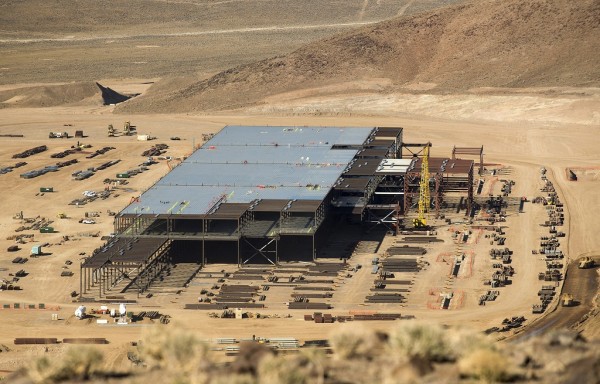Rio Tinto Posts Solid First Quarter Performance Despite Titanium and Iron Underproduction
| Eana Maniebo | | May 19, 2015 01:39 PM EDT |
(Photo : REUTERS)
Strong coal and copper production characterized global metal and mineral supplier Rio Tinto's first quarter performance for 2015, even though its titanium and iron ore output were weaker than expected.
Like Us on Facebook
Rio Tinto's copper production was 12 percent higher than the fourth quarter of 2014, thanks to higher output from its Escondida mine in Chile and Kennecott mine in Utah. Copper production at Escondida rebounded 35 percent from the same time last year mainly due to higher copper grades. It contributed to a 20 percent increase in tonnage compared to the previous quarter.
However, copper production at Kennecott was significantly lower compared to the first quarter of 2014, mainly due to lower grades and the current focus of deweighting and dewatering the east wall of Bingham Canyon.
Still, copper production in the area generally increased by 30 percent, as production in the previous quarter was impacted by a scheduled smelter maintenance shutdown. The company expects its share of mined copper production to be between 500,000 and 535,000 tons and refined copper production to be between 190,000 and 220,000 tons.
Coal delivered a beat driven by improved production rates at Kestrel South in Queensland, Australia following the long wall ramp-up, increased semi-soft production at Mount Thorley and Warkworth, and higher production at Hail Creek.
But wet weather took its toll on Rio Tinto's iron production at the start of this year as its Pilbara iron ore production in Western Australia was six percent lower at 71.1 million tons than the previous quarter. The company noted that this was a result of weather impacts from Tropical Cyclone Olwyn and a train derailment that temporarily blocked the inroad train circuit at Dampier.
Still, Rio Tinto maintained its previous guidance for iron ore global shipments, approaching 350 million tons from its operations in Canada and Australia. The Pilbara expansion infrastructure is nearing completion and remains on track for delivery by the end of the first half of 2015.
The company also confirmed that as much as it is ramping up its iron ore output despite the crash in the metal's prices, Rio Tinto has also been cutting its output of titanium minerals from its South African and Canadian operations due to a crash in the price of the said metal. Titanium dioxide production was 17 percent lower than in the first quarter of 2014, as production continued to be optimized to align with market demand. Hence, Rio Tinto's share of production is now expected to be 1.3 million tons of titanium dioxide slag compared to a guidance of 1.4 million tons in the previous quarter. Mineral sands like titanium peaked in 2011 and 2012, and prices have been down by as much as 68 percent in the intervening period.
However, Rio Tinto is not the only miner affected by the crashing titanium prices if such thing persists in the long run. Chile-based White Mountain Titanium Corporation (OTCQB: WMTM) is operating its flagship Cerro Blanco Project, which is expected to produce as much as 112 million tons of high grade rutile, which will eventually be used in the paints and pigments industry. White Mountain is expected to start production by 2017 after it completes its final feasibility.
The good news for these titanium miners is that only about 10 countries manufacture meaningful quantities of titanium dioxide, so the demand will always be up despite price fluctuations.
TagsRio Tinto, RIo Tinto titanium, coal and copper production, iron production, rutile companies, White Mountain Titanium, rutile mining in Chile
©2015 Chinatopix All rights reserved. Do not reproduce without permission
EDITOR'S PICKS
-

Did the Trump administration just announce plans for a trade war with ‘hostile’ China and Russia?
-

US Senate passes Taiwan travel bill slammed by China
-

As Yan Sihong’s family grieves, here are other Chinese students who went missing abroad. Some have never been found
-

Beijing blasts Western critics who ‘smear China’ with the term sharp power
-

China Envoy Seeks to Defuse Tensions With U.S. as a Trade War Brews
-

Singapore's Deputy PM Provides Bitcoin Vote of Confidence Amid China's Blanket Bans
-

China warns investors over risks in overseas virtual currency trading
-

Chinese government most trustworthy: survey
-

Kashima Antlers On Course For Back-To-Back Titles
MOST POPULAR
LATEST NEWS
Zhou Yongkang: China's Former Security Chief Sentenced to Life in Prison

China's former Chief of the Ministry of Public Security, Zhou Yongkang, has been given a life sentence after he was found guilty of abusing his office, bribery and deliberately ... Full Article
TRENDING STORY

China Pork Prices Expected to Stabilize As The Supplies Recover

Elephone P9000 Smartphone is now on Sale on Amazon India

There's a Big Chance Cliffhangers Won't Still Be Resolved When Grey's Anatomy Season 13 Returns

Supreme Court Ruled on Samsung vs Apple Dispute for Patent Infringement

Microsoft Surface Pro 5 Rumors and Release Date: What is the Latest?










